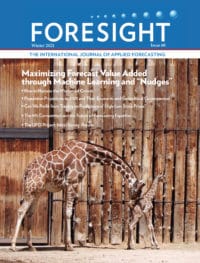 Through the M4 and M5 competitions, we've seen the promising performance of machine learning approaches in generating forecasts. The SAS whitepaper "Assisted Demand Planning Using Machine Learning for CPG and Retail" describes a role for ML in augmenting the demand planning by guiding the review and override of statistical forecasts. Now, in the Winter 2021 issue of Foresight: The International Journal of Applied Forecasting, Jeff Baker provides yet another new use for ML (in conjunction with behavioral economics). Below is Editor-in-Chief Len Tashman's preview of the new issue.
Through the M4 and M5 competitions, we've seen the promising performance of machine learning approaches in generating forecasts. The SAS whitepaper "Assisted Demand Planning Using Machine Learning for CPG and Retail" describes a role for ML in augmenting the demand planning by guiding the review and override of statistical forecasts. Now, in the Winter 2021 issue of Foresight: The International Journal of Applied Forecasting, Jeff Baker provides yet another new use for ML (in conjunction with behavioral economics). Below is Editor-in-Chief Len Tashman's preview of the new issue.
Preview of Foresight (Winter 2021)
The Winter 2021 issue of Foresight—issue number 60—features a new take on the concept of forecast value added. FVA was most fully developed by Michael Gilliland, a Foresight Associate Editor, to evaluate the net impact of a particular step in a forecasting process, such as a judgmental adjustment to a statistical forecast. A positive FVA means that the action led to an improvement in forecast accuracy. Negative values of FVA suggest that the process step should be a candidate for elimination.
But is it possible to determine in advance whether a certain action will add enough value to justify its cost? This is the question addressed by Jeff Baker in our feature article Maximizing Forecast Value Added through Machine Learning and “Nudges.” Here Jeff applies machine-learning methods to predict the FVA of a judgmental override from the characteristics of the override—its direction and size—along with the forecastability of the series. His article introduces several new constructs: the threshold FVA, the dispersion-scaled override, and the use of nudges rather than rigid rules to prompt forecasters to consider the desirability of overriding a statistical forecast. Robert Fildes and Michael Gilliland provide Commentaries on Jeff’s piece.
In his latest Hot New Research column, Paul Goodwin examines several new studies that show How to Harness the Wisdom of Crowds to extract maximum forecast accuracy.
Continuing his series of review articles on long-term demographic and economic projections, Ira Sohn presents A Peek at the Next Century: Population Projections to 2100 and Their Economic and Geopolitical Consequences.
While numerous studies of investment performance have offered tweaks on the “efficient markets” hypothesis, few have focused attention on daily high and low stock prices. Clive Jones believes that the H-L focus is worth consideration, asking Can We Profit from Trading on Predictions of High-Low Stock Prices?
The results are now in from the M5 competition, the latest, most realistic, and most ambitious of the Makridakis-inspired forecasting competitions. While there will be many analyses forthcoming in research journals of the methodologies, what the results hold in store for the future of the forecasting profession is explored here in the article The M5 Accuracy Competition and the Future of Human Expertise in Forecasting by Spyros Makridakis and Evangelos Spiliotis. We also feature a range of thought-provoking Commentaries by Stephan Kolassa, Simon Clarke, Michael Gilliland, Lawrence Vanston, and Tim Januschowski and colleagues at Amazon Web Services.
We close out the Winter 2021 issue with The UFO Project: Initial Survey Results. These are very preliminary findings on the usage of forecasting in small to medium-size companies. The survey instrument was designed by UFO Team member Jim Hoover.

3 Comments
It is unfortunate that an international journal labels its issues using northern hemisphere seasons, as if the southern hemisphere is irrelevant. It's not winter here.
Rob, thank you for pointing out this bias that had never occurred to me. You are right.
UPDATE: Foresight will be shifting to the Q1-Q4 (rather than season) labeling with the next issue -- it will now be Issue 61 (2021-Q2).